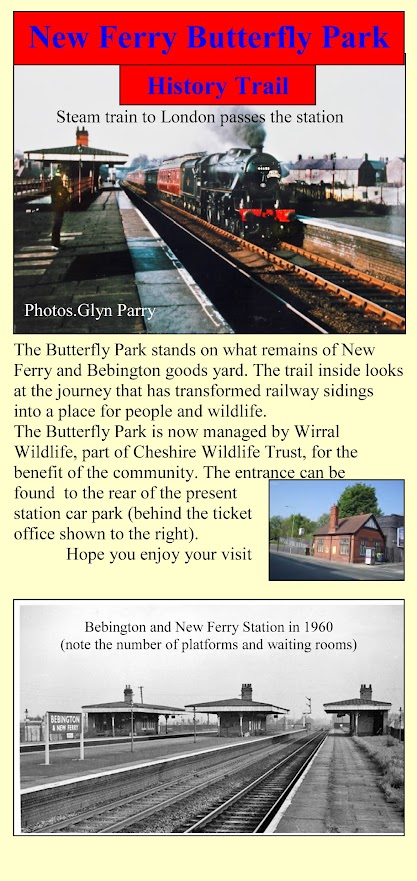 |
| History trail leaflet available on our website https://www.wirralwildlife.org.uk/new-ferry-butterfly-park |
Once steam trains finished on the Birkenhead - Chester line (March 6th 1967) the railway yard would have fallen into disuse very quickly. The larger pieces of metal were removed for recycling but sleepers and various oddments were left behind.
 |
| A coal truck |
British Rail had planning permission for industrial use but never succeeded in selling it for development. The original road access (Alma Street) had been blocked some years previously and obscured by fly-tipping. The goods yard was just left to go derelict, and nature moved in. The yard became a social problem, being used for drug-taking, drug-dealing, and small-scale crime such as emptying out stolen handbags, wallets and even safes. It was also used for children’s play and various other things – at one point a horse was tethered there.
In 1975, Mel (Melville) and Barbara Roberts and their
family moved into 20 Windsor Close, backing on to the goods yard. He watched
and recorded the wildlife on the goods yard, taking many photos.
In 1991 Mel decided to have another go at getting
recognition for the natural value of the site. That June, Hilary Ash was
helping staff a stall for Wirral Wildlife, at an event at Ness Gardens. Mel
Robert told her about the wildlife on the derelict railway goods yard behind
his house, especially butterflies and other insects. Hilary had done her PhD on
derelict industrial land so she knew that interesting wildlife could live on
derelict sites. Hilary went to see the goods yard in early July 1991. Impressed
with the site and Mel, she told Wirral Wildlife committee about it and chairman Frank Cottrell (whose main natural history interest was butterflies)
took the matter to Cheshire Wildlife Trust Council and staff. There was some
doubt among the staff as urban nature conservation was beginning to make waves
in 1991 but was still a new development. However the CEO Keith Roberts was
interested, and the CWT Council agreed to let Frank and Keith pursue the
possibility of taking it on as a nature reserve. Mel meanwhile organised a
public meeting and got around 30 people there, including police, schools,
Riverside Housing Association, local councillors and other community
representatives. There followed nearly 2 years of negotiation with British Rail
Property Board. When the red tape got impossible, we approached the then MP,
Barry Porter, for help. He succeeded in getting things moving, and a lease to
Cheshire Wildlife Trust was signed in September 1993. It was for a minimum 3
years, but indefinite after that.
Key people in pushing through that long 2 years, apart from Mel, were Frank Cottrell and our first NFBP chairman, Gordon Reid. Gordon arranged funding to re-fence the long eastern side, where the railway fence had long since fallen down, through Merseyside Safer Cities. The agreement with CWT was that the Park would be run by its own local group, financing itself and not needing any significant staff time. It was set up as a “community nature reserve” with a committee including local people who were not Cheshire Wildlife Trust members, as well as some who were. Mel got students from Bebington High School to come up with a name for the Park. New Ferry was already a run-down area and it was important that the name New Ferry was in the title.
Key people in pushing through that long 2 years, apart from Mel, were Frank Cottrell and our first NFBP chairman, Gordon Reid. Gordon arranged funding to re-fence the long eastern side, where the railway fence had long since fallen down, through Merseyside Safer Cities. The agreement with CWT was that the Park would be run by its own local group, financing itself and not needing any significant staff time. It was set up as a “community nature reserve” with a committee including local people who were not Cheshire Wildlife Trust members, as well as some who were. Mel got students from Bebington High School to come up with a name for the Park. New Ferry was already a run-down area and it was important that the name New Ferry was in the title.
After years
of effort New Ferry Butterfly Park opened its gates to visitors on 15th July 1995.
Mel always viewed one role of the Park as helping towards rejuvenating New Ferry. We hope we do help with that by giving local people a wildlife-rich place to visit.
Mel always viewed one role of the Park as helping towards rejuvenating New Ferry. We hope we do help with that by giving local people a wildlife-rich place to visit.




No comments:
Post a Comment